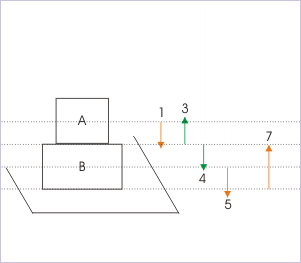| << Chapter < Page | Chapter >> Page > |
Let us now consider that we want to apply law of motion to block “B”. There are total of six forces related to “B” : 3, 4, 5, 6, 7 and 8. Of these, three forces 4, 5 and 7 act on “B”, while the remaining equal numbers of forces are applied by “B” on other bodies.
External forces acting on block b

From the point of view of the law of motion, there are, thus, only three forces as shown with red arrow in the figure, which are external force. These are the forces that the surrounding applies on the block "B".
Also as pointed out before in the course, we must not include internal forces like intermolecular forces in the consideration. In order to understand the role and implication of internal forces, we consider interaction of two blocks together with Earth’s surface. In this case, the forces 3 (B pushes up A) and 4 (A pushes down B) are pair of normal forces acting at the interface between blocks A and B. They are internal to the combined system of two bodies and as such are not taken into account for using law of motion. Here, external forces are 1 (Earth pulls down A), 5(Earth pulls down B) and 7(Earth pushes up B).
External and internal forces acting on blocks a and b

In nutshell, we must exclude (i) forces applied by the body and (ii) internal forces. Clearly, we must only consider external forces applied on the body while using equation of motion as given by Newton's second law.
As the force and acceleration are vector quantities, we can represent them with three components in mutually perpendicular directions. The consideration of dimension is decided by the force system as applied to the body.
If forces are collinear i.e. acting along a particular direction, then we use equation of motion in one direction. In such situation, it is possible to represent vector quantities with equivalent signed scalar quantities, in which sign indicates the direction. This is the simplest case.
If forces are coplanar i.e. acting in a plane, then we use component equations of motion in two directions. In such situation, we use component equations of motion in two directions.
Since each coordinate direction is bi-directional, we treat component vectors by equivalent scalar representation whose sign indicates direction. The important aspect of component equation of motion is that acceleration in a particular component direction is caused by net of force components in that direction and is independent of other net of component force in perpendicular direction.
In case forces are distributed in three dimensional volume, then we must consider component equation of motion in third perpendicular direction also :
We implicitly consider that forces are applied at a single point object. The forces that act on a point object are concurrent by virtue of the fact that a point is dimensionless entity. This may appear to be confusing as we have actually used the word “body” – not “point” in the definition of second law. Here, we need to appreciate the intended meaning clearly.

Notification Switch
Would you like to follow the 'Physics for k-12' conversation and receive update notifications?